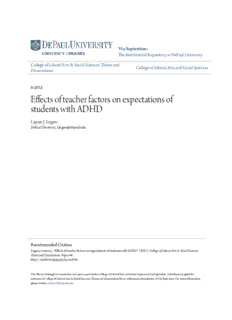
Effects of teacher factors on expectations of students with ADHD PDF
Preview Effects of teacher factors on expectations of students with ADHD
DDeePPaauull UUnniivveerrssiittyy DDiiggiittaall CCoommmmoonnss@@DDeePPaauull College of Liberal Arts & Social Sciences College of Liberal Arts and Social Sciences Theses and Dissertations 6-2011 EEffffeeccttss ooff tteeaacchheerr ffaaccttoorrss oonn eexxppeeccttaattiioonnss ooff ssttuuddeennttss wwiitthh AADDHHDD Lauren J. Legato DePaul University, [email protected] Follow this and additional works at: https://via.library.depaul.edu/etd RReeccoommmmeennddeedd CCiittaattiioonn Legato, Lauren J., "Effects of teacher factors on expectations of students with ADHD" (2011). College of Liberal Arts & Social Sciences Theses and Dissertations. 66. https://via.library.depaul.edu/etd/66 This Thesis is brought to you for free and open access by the College of Liberal Arts and Social Sciences at Digital Commons@DePaul. It has been accepted for inclusion in College of Liberal Arts & Social Sciences Theses and Dissertations by an authorized administrator of Digital Commons@DePaul. For more information, please contact [email protected]. EFFECTS OF TEACHER FACTORS ON EXPECTATIONS OF STUDENTS WITH ADHD A Thesis Presented in Partial Fulfillment of the Requirements for the Degree of Master of Arts BY LAUREN LEGATO SEPTEMBER 14, 2010 Department of Psychology College of Liberal Arts and Sciences DePaul University Chicago, Illinois ii THESIS COMMITTEE Karen S. Budd, Ph.D. Chairperson Jocelyn S. Carter, Ph.D. iii ACKNOWLEDGMENTS I would like to express my sincere gratitude to my thesis chair, Dr. Karen Budd, and committee member, Dr. Jocelyn Carter, for their guidance and encouragement throughout this process. I would also like to thank the Chicago Public Schools for granting me permission to conduct my study with their teachers. I am grateful to the principals and teachers who took the time to complete the surveys for this study. Finally, I would like to acknowledge the Doctoral-Undergraduate Opportunities for Scholarship (DUOS) grant from DePaul University which provided the funding for conducting this research project, and the invaluable assistance from my DUOS undergraduate scholar, Adam Ramsey. iv VITA The author was born in Washington, D.C., August 19, 1979. She received her Bachelor of Science degree from Vanderbilt University in 2001, and a Master of Arts degree in Clinical Psychology from Teachers College, Columbia University in 2007. v LIST OF TABLES Table 1. Sample Size, Means, and Standard Deviations for Measures ………… 30 Table 2. Intercorrelations Among Measures ……………………….................... 30 vi LIST OF FIGURES Figure 1. Visual Model of Hypothesized Relationships Among Variables .....… 18 vii TABLE OF CONTENTS Thesis Committee ……………………………………………………………….. ii Acknowledgments………………………………………………………………. iii Vita ……………………………………………………………………………… iv List of Tables ……………………………………………………………………. v List of Figures …………………………………………………………………... vi CHAPTER I. INTRODUCTION ………………………………………………. 1 Teacher Knowledge ……………………………………………………... 3 Teacher Self-Efficacy …………………………………………………… 5 Teacher Expectations ………………………………………………….. 13 Rationale ……………………………………………………………….. 16 Statement of Hypotheses and Research Questions …………………….. 18 CHAPTER II. METHODS ……………………………………………………. 20 Research Participants …………………………………………………... 20 Procedure ………………………………………………………………. 21 Measures ……………………………………………………………….. 23 CHAPTER III. RESULTS …………………………………………………….. 29 CHAPTER IV. DISCUSSION………………………………………………… 39 CHAPTER V. SUMMARY …………………………………………………… 45 References ……………………………………………………………………….47 Appendix A. Teacher Information Form ...…………………………………….. 54 Appendix B. Letter to Principals …...………………………………………….. 56 Appendix C. Chicago Public Schools Permission .…………………………….. 58 Appendix D. Demographics Questionnaire ……………………………………. 60 Appendix E. Teachers’ Sense of Efficacy Scale ……………………………….. 64 viii Appendix F. Knowledge of Attention Deficit Disorders Scale ………………... 66 Appendix G. Sample Vignettes ………………………………………………… 70 1 CHAPTER I INTRODUCTION Attention-Deficit/ Hyperactivity Disorder (ADHD) is characterized by impairing symptoms of inattention and/or hyperactivity (American Psychiatric Association [APA], 2000). Prevalence rates in the general U.S. population fall between 3 and 8% (APA, 2000), with estimates in school populations closer to 8% (Gaub & Carlson, 1997). Given the high incidence of ADHD in school populations, teachers are likely to teach multiple children with ADHD in their classrooms over the course of their careers. Disruptive behavior often associated with ADHD can be difficult for teachers to manage in the classroom and impairing for a child’s academic, social, and emotional growth (Kos, Richdale, & Hay, 2006). Research has shown that untreated ADHD places children at risk for a host of problems that may persist and worsen in adulthood (Goksoyr & Nottestad, 2008), including conduct problems (Wilens, Biederman, & Spencer, 2002), academic underachievement (Barry, Lyman, & Klinger, 2002), and substance abuse (Biederman, Wilens, Mick, Spencer, & Faraone, 1999). Especially true in urban communities where mental health care access is limited (Atkins, Graczyk, Frazier, & Abdul-Adil, 2003), teachers are often on the front line in seeking referrals for children and carrying out school-based interventions (Barbaresi & Olsen, 1998; Graczyk et al., 2005). Without adequate knowledge or training on ADHD for addressing children’s needs in the classroom, teachers may feel
Description: